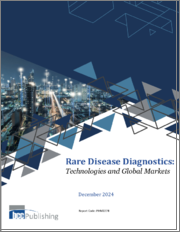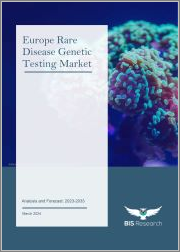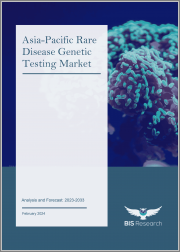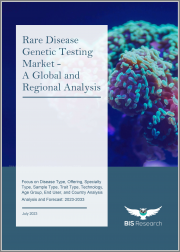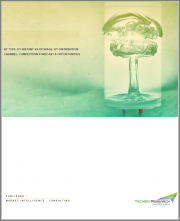
|
시장보고서
상품코드
1289657
희귀질환 진단 시장 - 세계 산업 규모, 점유율, 동향, 기회, 예측(2017-2027년), 적응증별, 형질 유형별, 검사 유형별, 기술별, 샘플 유형별, 최종사용자별, 기업별, 지역별 세분화Rare Disease Diagnostics Market - Global Industry Size, Share, Trends, Opportunity, and Forecast, 2017-2027 Segmented By Indication, By Trait Type, By Test Type, By Technology, By Sample Type, By End User, By company and By Region |
||||||
세계 희귀질환 진단 시장은 2023-2027년 예측 기간 동안 괄목할 만한 성장을 보일 것으로 예상됩니다.
희귀질환 발생률 증가, 첨단 기술 도입, 연구개발 투자 증가 등이 시장 성장을 촉진하는 주요 요인으로 꼽힙니다. 희귀질환은 인구의 극히 일부가 앓고 있는 모든 질병을 말합니다. 기타 시장 성장 요인으로는 인식 개선을 위한 정부의 노력, 희귀질환 환자 등록 확대, 시퀀싱 비용 감소, 노인 인구 증가, 희귀질환 진단 프로그램 및 신제품 개발 증가, 연구개발 활동 증가 등이 있습니다.
희귀질환 발생률의 증가는 시장 성장을 촉진할 것입니다.
희귀질환은 그 질환을 앓고 있는 사람이 많기 때문에 희귀하다고 할 수 없습니다. 희귀질환은 에이즈와 암을 합친 것보다 더 많은 사람들에게 영향을 미칩니다. 예를 들어, European Journal of Human Genetics에 따르면 희귀질환을 앓고 있는 사람의 수는 전 세계적으로 3억 명으로 추산됩니다. 아가마글로불린혈증, 굿파셔 증후군, 다발성 혈관염 육아종증(GPA, 구 베게너 육아종증), 백혈구 접착결핍증, 소아 브루톤 아가마글로불린혈증, 소아 중증복합면역결핍증, 슈니츨러 증후군과 같은 희귀질환을 앓고 있는 사람들이 증가함에 따라 진단에 대한 수요가 급증하면서 시장 성장을 견인하고 있습니다.
질병 진단의 기술적 발전
희귀질환 진단 분야의 첨단 기술 채택이 증가하면서 시장 성장을 견인하고 있습니다. 인공지능(AI), NGS 기반 검사, 자동화 기술과 같은 새로운 혁신 기술과 발전은 표준 수동 분석에 비해 시간과 비용을 절감하고 보다 정확한 진단을 가능하게 합니다. 예를 들어, 전체 엑솜 시퀀싱(WES) 유전자 검사 도구의 채택이 증가하고 있습니다. 이 기술은 전체 게놈의 1-2%를 차지하는 엑손만을 대상으로 하며, 질병을 유발하는 돌연변이의 80%를 포함하고 있습니다.
희귀질환 진단에 대한 인식 제고
희귀질환의 조기 진단은 사람들이 고통을 겪지 않고 적시에 치료할 수 있도록 도와주기 때문에 필수적입니다. 따라서 일반 대중과 환자들 사이에서 희귀질환에 대한 인식이 높아짐에 따라 시장 성장을 촉진하고 있습니다. 정부 및 비정부기구는 질병의 조기 진단과 치료에 대한 인식을 높이기 위해 다양한 노력을 기울이고 있습니다. 예를 들어, 매년 NIH에서 개최되는 희귀질환의 날은 희귀질환과 환자의 삶에 미치는 영향에 대한 인식을 높이는 것을 목표로 하고 있습니다.
이용 가능한 커스터마이징
TechSci Research는 주어진 시장 데이터를 기반으로 기업의 특정 요구에 따라 맞춤형을 제공합니다. 본 보고서는 다음과 같은 커스터마이징이 가능합니다.
기업 정보
- 추가 시장 참여자(최대 5개사)에 대한 상세한 분석 및 프로파일링
목차
제1장 개요
제2장 조사 방법
제3장 주요 요약
제4장 COVID-19가 세계의 희귀질환 진단 시장에 미치는 영향
제5장 고객의 소리
제6장 희귀질환 진단 세계 시장 전망
- 시장 규모와 예측
- 금액별
- 시장 점유율과 예측
- 적응증별(소화기질환, 내분비·대사질환, 순환기질환, 혈액·종양 질환, 기타)
- 형질 유형별(유전성/후천성)
- 검사 유형별(유전자 검사, 일반 임상 검사, 영상 진단, 기타)
- 기술별(차세대 시퀸싱, 전게놈 시퀀싱, 전엑솜 시퀀싱, 마이크로어레이, 기타)
- 샘플 유형별(DNA 샘플, 혈액 샘플, 타액 샘플, 기타)
- 최종사용자별(병원·클리닉, 학술·연구기관, 기타)
- 지역별
- 기업별(2021년)
- 시장 맵
제7장 북미의 희귀질환 진단 시장 전망
- 시장 규모와 예측
- 금액별
- 시장 점유율과 예측
- 적응증별
- 형질 유형별
- 검사 유형별
- 기술별
- 샘플 유형별
- 최종사용자별
- 국가별
- 북미의 경우 국가별 분석
- 미국
- 캐나다
- 멕시코
제8장 유럽의 희귀질환 진단 시장 전망
- 시장 규모와 예측
- 금액별
- 시장 점유율과 예측
- 적응증별
- 형질 유형별
- 검사 유형별
- 기술별
- 샘플 유형별
- 최종사용자별
- 국가별
- 유럽 국가별 분석
- 프랑스
- 독일
- 영국
- 이탈리아
- 스페인
제9장 아시아태평양의 희귀질환 진단 시장 전망
- 시장 규모와 예측
- 금액별
- 시장 점유율과 예측
- 적응증별
- 형질 유형별
- 검사 유형별
- 기술별
- 샘플 유형별
- 최종사용자별
- 국가별
- 아시아태평양의 국가별 분석
- 중국
- 인도
- 일본
- 한국
- 호주
제10장 남미의 희귀질환 진단 시장 전망
- 시장 규모와 예측
- 금액별
- 시장 점유율과 예측
- 적응증별
- 형질 유형별
- 검사 유형별
- 기술별
- 샘플 유형별
- 최종사용자별
- 국가별
- 남미의 국가별 분석
- 브라질
- 아르헨티나
- 콜롬비아
제11장 중동 및 아프리카의 희귀질환 진단 시장 전망
- 시장 규모와 예측
- 금액별
- 시장 점유율과 예측
- 적응증별
- 형질 유형별
- 검사 유형별
- 기술별
- 샘플 유형별
- 최종사용자별
- 국가별
- MEA : 국가별 분석
- 남아프리카공화국 희귀질환 진단약
- 사우디아라비아 희귀질환 진단약
- UAE 희귀질환 진단약
제12장 시장 역학
- 성장 촉진요인
- 과제
제13장 시장 동향과 개척
제14장 경쟁 상황(SWOT 분석도 포함)
- Agilent Technologies, Inc.
- Illumina, Inc.
- QIAGEN NV
- PerkinElmer, Inc
- Quest Diagnostics, Inc.
- CENTOGENE N.V.
- 23andMe, Inc.
- 3billion, Inc.
- Eurofins Scientific SE
- Invitae Corporation
제15장 전략적 제안
ksm 23.07.04The global rare disease diagnostics market is anticipated to observe impressive growth during the forecast period 2023-2027. The major factors include the growing incidence of rare disorders, adoption of advanced technology, and increase in investments in R&D are impelling the growth of the market. Rare diseases or orphan diseases is any disease that affects a small percentage of the population. The other factors supporting the market's growth are, increasing government initiatives for spreading awareness, expanding patient registry for rare diseases, declining sequencing cost, rising geriatric population, the growing launch of programs & new product development in rare disease diagnosis, and rise in research and development activities.
The rising incidence of rare disorders will fuel the market growth.
Rare diseases are not rarer as there are many people who are suffering from the disease. They affect more people than the combination of AIDS & Cancer. For instance, as per the European Journal of Human Genetics, the number of people living with a rare disease is estimated at 300 million across the globe. Owing to the rise in the number of people suffering from rare diseases such as Agammaglobulinemia, Goodpasture Syndrome, Granulomatosis with Polyangiitis (GPA, formerly Wegener Granulomatosis), Leukocyte Adhesion Deficiency, Pediatric Bruton Agammaglobulinemia, Pediatric Severe Combined Immunodeficiency, Schnitzler Syndrome and others, the surge in demand for the diagnosis is bolstering the growth of the market.
Technological Advancements in Disease Diagnosis
The rise in the adoption of advanced technology in the field of rare diseases diagnostic is augmenting the growth of the market. New innovative technologies and advancements such as artificial intelligence (AI), NGS-based testing, and automation technology are assisting in reducing time and cost and enabling more accurate diagnosis when compared to standard manual analysis. For instance, increase in the adoption of the Whole Exome Sequencing (WES) genetic testing tool. The technique aims only at exons, which make 1-2% of the whole genome and include 80% of all disease-causing mutations.
Rising Awareness of diagnosis of rare diseases
Early diagnosis of rare diseases is essential as it can help people to treat these conditions timely without suffering. Thus, the rise in awareness about rare diseases among the general public and patients is facilitating the growth of the market. Various initiatives by government and non-government organizations are taken to make people aware of the early diagnosis and treatment of the disease. For instance, every year, rare diseases day at NIH takes place, which aims to raise awareness about rare diseases and the impact they have on patient's lives.
Market Segmentation
The global rare disease diagnostics market is segmented into indication, trait type, test type, technology, sample type, end user, and company. Based on indication, the market is divided into gastroenterology disease, endocrine & metabolism disorders disease, cardiovascular disorders, hematology & oncology disease, and others. Based on trait type, the market is divided into inherited and acquired. Based on test type, the market is segmented into genetic tests, general lab tests, diagnostic imaging, and others. Based on technology, the market is divided into next-generation sequencing, whole genome sequencing, whole exome sequencing, microarrays, and others. Based on sample type, the market is divided into DNA samples, blood sample, saliva samples, and others. Based on end-user, the market is divided into hospitals & clinics, academic & research institutes, and others. In terms of country, the United States is expected to be a lucrative market in the forecast period due to rising occurrences of rare diseases in the country.
Market Players
Agilent Technologies, Inc., Illumina, Inc., QIAGEN NV, PerkinElmer, Inc, Quest Diagnostics, Inc., CENTOGENE N.V., 23andMe, Inc., 3billion, Inc., Eurofins Scientific SE, and Invitae Corporation are some of the leading companies operating in the market.
Report Scope
In this report, global rare disease diagnostics market has been segmented into the following categories, in addition to the industry trends which have also been detailed below:
Rare Disease Diagnostics Market, By Indication:
- Gastroenterology Disease
- Endocrine & Metabolism Disorders Disease
- Cardiovascular Disorders
- Hematology & Oncology Disease
- Others
Rare Disease Diagnostics Market, By Trait Type:
- Inherited
- Acquired
Rare Disease Diagnostics Market, By Test Type:
- Genetic Tests
- General Lab Tests
- Diagnostic Imaging
- Others
Rare Disease Diagnostics Market, By Technology:
- Next Generation Sequencing
- Whole Genome Sequencing
- Whole Exome Sequencing
- Microarrays
- Others
Rare Disease Diagnostics Market, By Sample Type:
- DNA Sample
- Blood Sample
- Saliva Sample
- Others
Rare Disease Diagnostics Market, By End User:
- Hospitals & Clinics
- Academic & Research Institutes
- Others
Rare Disease Diagnostics Market, By Region:
- North America
- United States
- Canada
- Mexico
- Asia-Pacific
- China
- India
- Japan
- Australia
- South Korea
- Europe & CIS
- Germany
- France
- United Kingdom
- Spain
- Italy
- South America
- Brazil
- Argentina
- Colombia
- Middle East & Africa
- South Africa
- Saudi Arabia
- UAE
Competitive Landscape
Company Profiles: Detailed analysis of the major companies present in Global Rare Disease Diagnostics Market
Available Customizations
With the given market data, TechSci Research offers customizations according to a company's specific needs. The following customization options are available for the report:
Company Information
- Detailed analysis and profiling of additional market players (up to five).
Table of Contents
1. Product Overview
2. Research Methodology
3. Executive Summary
4. Impact of COVID-19 on Global Rare Disease Diagnostics Market
5. Voice of Customer
6. Global Rare Disease Diagnostics Market Outlook
- 6.1. Market Size & Forecast
- 6.1.1. By Value
- 6.2. Market Share & Forecast
- 6.2.1. By Indication (Gastroenterology Disease, Endocrine & Metabolism Disorders Disease, Cardiovascular Disorders, Hematology & Oncology Disease, Others)
- 6.2.2. By Trait Type (Inherited v/s Acquired)
- 6.2.3. By Test Type (Genetic Tests, General Lab Tests, Diagnostic Imaging, Others)
- 6.2.4. By Technology (Next Generation Sequencing, Whole Genome Sequencing, Whole Exome Sequencing, Microarrays, Others)
- 6.2.5. By Sample Type (DNA Sample, Blood Sample, Saliva Sample, Others)
- 6.2.6. By End User (Hospitals & Clinics, Academic & Research Institutes, Others)
- 6.2.7. By Region
- 6.2.8. By Company (2021)
- 6.3. Market Map
7. North America Rare Disease Diagnostics Market Outlook
- 7.1. Market Size & Forecast
- 7.1.1. By Value
- 7.2. Market Share & Forecast
- 7.2.1. By Indication
- 7.2.2. By Trait Type
- 7.2.3. By Test Type
- 7.2.4. By Technology
- 7.2.5. By Sample Type
- 7.2.6. By End User
- 7.2.7. By Country
- 7.3. North America: Country Analysis
- 7.3.1. United States Rare Disease Diagnostics Market Outlook
- 7.3.1.1. Market Size & Forecast
- 7.3.1.1.1. By Value
- 7.3.1.2. Market Share & Forecast
- 7.3.1.2.1. By Indication
- 7.3.1.2.2. By Trait Type
- 7.3.1.2.3. By Test Type
- 7.3.1.2.4. By Technology
- 7.3.1.2.5. By Sample Type
- 7.3.1.2.6. By End User
- 7.3.1.1. Market Size & Forecast
- 7.3.2. Canada Rare Disease Diagnostics Market Outlook
- 7.3.2.1. Market Size & Forecast
- 7.3.2.1.1. By Value
- 7.3.2.2. Market Share & Forecast
- 7.3.2.2.1. By Indication
- 7.3.2.2.2. By Trait Type
- 7.3.2.2.3. By Test Type
- 7.3.2.2.4. By Technology
- 7.3.2.2.5. By Sample Type
- 7.3.2.2.6. By End User
- 7.3.2.1. Market Size & Forecast
- 7.3.3. Mexico Rare Disease Diagnostics Market Outlook
- 7.3.3.1. Market Size & Forecast
- 7.3.3.1.1. By Value
- 7.3.3.2. Market Share & Forecast
- 7.3.3.2.1. By Indication
- 7.3.3.2.2. By Trait Type
- 7.3.3.2.3. By Test Type
- 7.3.3.2.4. By Technology
- 7.3.3.2.5. By Sample Type
- 7.3.3.2.6. By End User
- 7.3.3.1. Market Size & Forecast
- 7.3.1. United States Rare Disease Diagnostics Market Outlook
8. Europe Rare Disease Diagnostics Market Outlook
- 8.1. Market Size & Forecast
- 8.1.1. By Value
- 8.2. Market Share & Forecast
- 8.2.1. By Indication
- 8.2.2. By Trait Type
- 8.2.3. By Test Type
- 8.2.4. By Technology
- 8.2.5. By Sample Type
- 8.2.6. By End User
- 8.2.7. By Country
- 8.3. Europe: Country Analysis
- 8.3.1. France Rare Disease Diagnostics Market Outlook
- 8.3.1.1. Market Size & Forecast
- 8.3.1.1.1. By Value
- 8.3.1.2. Market Share & Forecast
- 8.3.1.2.1. By Indication
- 8.3.1.2.2. By Trait Type
- 8.3.1.2.3. By Test Type
- 8.3.1.2.4. By Technology
- 8.3.1.2.5. By Sample Type
- 8.3.1.2.6. By End User
- 8.3.1.1. Market Size & Forecast
- 8.3.2. Germany Rare Disease Diagnostics Market Outlook
- 8.3.2.1. Market Size & Forecast
- 8.3.2.1.1. By Value
- 8.3.2.2. Market Share & Forecast
- 8.3.2.2.1. By Indication
- 8.3.2.2.2. By Trait Type
- 8.3.2.2.3. By Test Type
- 8.3.2.2.4. By Technology
- 8.3.2.2.5. By Sample Type
- 8.3.2.2.6. By End User
- 8.3.2.1. Market Size & Forecast
- 8.3.3. United Kingdom Rare Disease Diagnostics Market Outlook
- 8.3.3.1. Market Size & Forecast
- 8.3.3.1.1. By Value
- 8.3.3.2. Market Share & Forecast
- 8.3.3.2.1. By Indication
- 8.3.3.2.2. By Trait Type
- 8.3.3.2.3. By Test Type
- 8.3.3.2.4. By Technology
- 8.3.3.2.5. By Sample Type
- 8.3.3.2.6. By End User
- 8.3.3.1. Market Size & Forecast
- 8.3.4. Italy Rare Disease Diagnostics Market Outlook
- 8.3.4.1. Market Size & Forecast
- 8.3.4.1.1. By Value
- 8.3.4.2. Market Share & Forecast
- 8.3.4.2.1. By Indication
- 8.3.4.2.2. By Trait Type
- 8.3.4.2.3. By Test Type
- 8.3.4.2.4. By Technology
- 8.3.4.2.5. By Sample Type
- 8.3.4.2.6. By End User
- 8.3.4.1. Market Size & Forecast
- 8.3.5. Spain Rare Disease Diagnostics Market Outlook
- 8.3.5.1. Market Size & Forecast
- 8.3.5.1.1. By Value
- 8.3.5.2. Market Share & Forecast
- 8.3.5.2.1. By Indication
- 8.3.5.2.2. By Trait Type
- 8.3.5.2.3. By Test Type
- 8.3.5.2.4. By Technology
- 8.3.5.2.5. By Sample Type
- 8.3.5.2.6. By End User
- 8.3.5.1. Market Size & Forecast
- 8.3.1. France Rare Disease Diagnostics Market Outlook
9. Asia-Pacific Rare Disease Diagnostics Market Outlook
- 9.1. Market Size & Forecast
- 9.1.1. By Value
- 9.2. Market Share & Forecast
- 9.2.1. By Indication
- 9.2.2. By Trait Type
- 9.2.3. By Test Type
- 9.2.4. By Technology
- 9.2.5. By Sample Type
- 9.2.6. By End User
- 9.2.7. By Country
- 9.3. Asia-Pacific: Country Analysis
- 9.3.1. China Rare Disease Diagnostics Market Outlook
- 9.3.1.1. Market Size & Forecast
- 9.3.1.1.1. By Value
- 9.3.1.2. Market Share & Forecast
- 9.3.1.2.1. By Indication
- 9.3.1.2.2. By Trait Type
- 9.3.1.2.3. By Test Type
- 9.3.1.2.4. By Technology
- 9.3.1.2.5. By Sample Type
- 9.3.1.2.6. By End User
- 9.3.1.1. Market Size & Forecast
- 9.3.2. India Rare Disease Diagnostics Market Outlook
- 9.3.2.1. Market Size & Forecast
- 9.3.2.1.1. By Value
- 9.3.2.2. Market Share & Forecast
- 9.3.2.2.1. By Indication
- 9.3.2.2.2. By Trait Type
- 9.3.2.2.3. By Test Type
- 9.3.2.2.4. By Technology
- 9.3.2.2.5. By Sample Type
- 9.3.2.2.6. By End User
- 9.3.2.1. Market Size & Forecast
- 9.3.3. Japan Rare Disease Diagnostics Market Outlook
- 9.3.3.1. Market Size & Forecast
- 9.3.3.1.1. By Value
- 9.3.3.2. Market Share & Forecast
- 9.3.3.2.1. By Indication
- 9.3.3.2.2. By Trait Type
- 9.3.3.2.3. By Test Type
- 9.3.3.2.4. By Technology
- 9.3.3.2.5. By Sample Type
- 9.3.3.2.6. By End User
- 9.3.3.1. Market Size & Forecast
- 9.3.4. South Korea Rare Disease Diagnostics Market Outlook
- 9.3.4.1. Market Size & Forecast
- 9.3.4.1.1. By Value
- 9.3.4.2. Market Share & Forecast
- 9.3.4.2.1. By Indication
- 9.3.4.2.2. By Trait Type
- 9.3.4.2.3. By Test Type
- 9.3.4.2.4. By Technology
- 9.3.4.2.5. By Sample Type
- 9.3.4.2.6. By End User
- 9.3.4.1. Market Size & Forecast
- 9.3.5. Australia Rare Disease Diagnostics Market Outlook
- 9.3.5.1. Market Size & Forecast
- 9.3.5.1.1. By Value
- 9.3.5.2. Market Share & Forecast
- 9.3.5.2.1. By Indication
- 9.3.5.2.2. By Trait Type
- 9.3.5.2.3. By Test Type
- 9.3.5.2.4. By Technology
- 9.3.5.2.5. By Sample Type
- 9.3.5.2.6. By End User
- 9.3.5.1. Market Size & Forecast
- 9.3.1. China Rare Disease Diagnostics Market Outlook
10. South America Rare Disease Diagnostics Market Outlook
- 10.1. Market Size & Forecast
- 10.1.1. By Value
- 10.2. Market Share & Forecast
- 10.2.1. By Indication
- 10.2.2. By Trait Type
- 10.2.3. By Test Type
- 10.2.4. By Technology
- 10.2.5. By Sample Type
- 10.2.6. By End User
- 10.2.7. By Country
- 10.3. South America: Country Analysis
- 10.3.1. Brazil Rare Disease Diagnostics Market Outlook
- 10.3.1.1. Market Size & Forecast
- 10.3.1.1.1. By Value
- 10.3.1.2. Market Share & Forecast
- 10.3.1.2.1. By Indication
- 10.3.1.2.2. By Trait Type
- 10.3.1.2.3. By Test Type
- 10.3.1.2.4. By Technology
- 10.3.1.2.5. By Sample Type
- 10.3.1.2.6. By End User
- 10.3.1.1. Market Size & Forecast
- 10.3.2. Argentina Rare Disease Diagnostics Market Outlook
- 10.3.2.1. Market Size & Forecast
- 10.3.2.1.1. By Value
- 10.3.2.2. Market Share & Forecast
- 10.3.2.2.1. By Indication
- 10.3.2.2.2. By Trait Type
- 10.3.2.2.3. By Test Type
- 10.3.2.2.4. By Technology
- 10.3.2.2.5. By Sample Type
- 10.3.2.2.6. By End User
- 10.3.2.1. Market Size & Forecast
- 10.3.3. Colombia Rare Disease Diagnostics Market Outlook
- 10.3.3.1. Market Size & Forecast
- 10.3.3.1.1. By Value
- 10.3.3.2. Market Share & Forecast
- 10.3.3.2.1. By Indication
- 10.3.3.2.2. By Trait Type
- 10.3.3.2.3. By Test Type
- 10.3.3.2.4. By Technology
- 10.3.3.2.5. By Sample Type
- 10.3.3.2.6. By End User
- 10.3.3.1. Market Size & Forecast
- 10.3.1. Brazil Rare Disease Diagnostics Market Outlook
11. Middle East and Africa Rare Disease Diagnostics Market Outlook
- 11.1. Market Size & Forecast
- 11.1.1. By Value
- 11.2. Market Share & Forecast
- 11.2.1. By Indication
- 11.2.2. By Trait Type
- 11.2.3. By Test Type
- 11.2.4. By Technology
- 11.2.5. By Sample Type
- 11.2.6. By End User
- 11.2.7. By Country
- 11.3. MEA: Country Analysis
- 11.3.1. South Africa Rare Disease Diagnostics Market Outlook
- 11.3.1.1. Market Size & Forecast
- 11.3.1.1.1. By Value
- 11.3.1.2. Market Share & Forecast
- 11.3.1.2.1. By Indication
- 11.3.1.2.2. By Trait Type
- 11.3.1.2.3. By Test Type
- 11.3.1.2.4. By Technology
- 11.3.1.2.5. By Sample Type
- 11.3.1.2.6. By End User
- 11.3.1.1. Market Size & Forecast
- 11.3.2. Saudi Arabia Rare Disease Diagnostics Market Outlook
- 11.3.2.1. Market Size & Forecast
- 11.3.2.1.1. By Value
- 11.3.2.2. Market Share & Forecast
- 11.3.2.2.1. By Indication
- 11.3.2.2.2. By Trait Type
- 11.3.2.2.3. By Test Type
- 11.3.2.2.4. By Technology
- 11.3.2.2.5. By Sample Type
- 11.3.2.2.6. By End User
- 11.3.2.1. Market Size & Forecast
- 11.3.3. UAE Rare Disease Diagnostics Market Outlook
- 11.3.3.1. Market Size & Forecast
- 11.3.3.1.1. By Value
- 11.3.3.2. Market Share & Forecast
- 11.3.3.2.1. By Indication
- 11.3.3.2.2. By Trait Type
- 11.3.3.2.3. By Test Type
- 11.3.3.2.4. By Technology
- 11.3.3.2.5. By Sample Type
- 11.3.3.2.6. By End User
- 11.3.3.1. Market Size & Forecast
- 11.3.1. South Africa Rare Disease Diagnostics Market Outlook
12. Market Dynamics
- 12.1. Drivers
- 12.2. Challenges
13. Market Trends & Developments
14. Competitive Landscape (Inclusive of SWOT Analysis)
- 14.1. Agilent Technologies, Inc.
- 14.2. Illumina, Inc.
- 14.3. QIAGEN NV
- 14.4. PerkinElmer, Inc
- 14.5. Quest Diagnostics, Inc.
- 14.6. CENTOGENE N.V.
- 14.7. 23andMe, Inc.
- 14.8. 3billion, Inc.
- 14.9. Eurofins Scientific SE
- 14.10. Invitae Corporation






